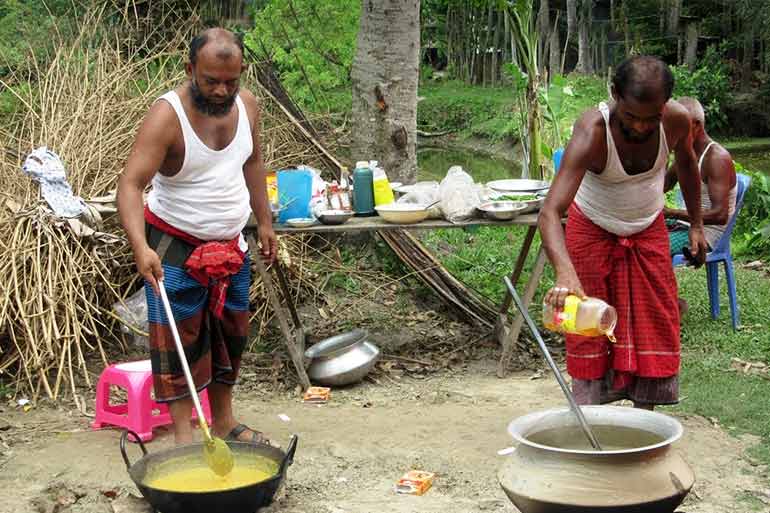Rosogolla – Whose Is It Really? – GetBengal story

Rosogolla – Whose Is It Really? Bengal and Odisha have been locked in a loud tug-of-war over this sweet delicacy for years. Finally, Bengal won the battle. In November 2018, Rosogolla received the GI (Geographical Indication) tag under the name “Banglar Rosogolla”. Since then, Rosgolla Day has been celebrated in honour of this recognition.
Even though Bengal and Odisha flexed their muscles over this battle, the two neighbours have long had a fascinating coexistence when it comes to food. Perhaps it is because they share borders. Looking back into history, we find that Odia chefs (known as Odissi chefs or Ure Brahmins) have been an integral part of Kolkata kitchens for centuries. It is their artistry that brought countless delicacies to the Bengali platter.
Many global influences have shaped the Bengali palate into what it is today.From Persia, Portugal, Britain, and China to local Indian traditions, streams of culinary culture have merged on the banks of Bengal. Food has become inseparable from Bengali culture. Over time, through the ancient, medieval, and modern eras, dietary habits evolved. Persians, Turks, Afghans, and Arabs, in their quest for empire-building, brought not only their culture but also their food habits into Bengal. By the 1500s, the Portuguese had arrived; in the 16th century, the British came; and by the late 1500s, the Dutch and French had also entered Bengal. Around 80 years after the Mughal Empire was established, Dhaka gained the status of Suba Bengal’s capital. These historical developments were enough to reshape the culinary map of Bengal.

Thus, Bengalis, across generations, welcomed the flavours of different nations with open arms. During the Mughal era, Bengal and Odisha were united under the same rule, which ensured that regionalism in cuisine did not creep into the kitchens of Bengal.
Even in the 14th century, we find food references in the Charyapada, an early collection of Buddhist mystical songs. In one poem, the poet laments a lack of rice when a guest arrives. In the Chaitanya Charitamrita, written by Krishnadas Kaviraj in the 15th century, there is mention of serving hot rice with ghee on banana leaves to Mahaprabhu at the Bhattacharya household. These examples prove that rice was the staple food of Bengalis even in ancient times. Alongside, Odia chefs left a notable influence on Bengali kitchens.
Kolkata has always been a melting pot of cultures and cuisines. Some dishes came from the Portuguese kitchens, others from the Mughal pakghars, and still others from British culinary traditions. With these dishes came the chefs themselves. While the dishes are remembered, the names of the chefs behind them are often forgotten, yet their creations have delighted palates for generations.
Even today, Odia chefs continue to be in demand in Kolkata. From the 1960s onward, the term “cook” or “chef” in a Bengali household almost always meant an Odia man. Until about twenty years ago, when catering services began dominating, Bengali families would rush to Bhabanipur’s Odia settlement or the Mudiyaali area in South Kolkata in search of cooks for family events. In North Kolkata, food-loving Bengalis would look for skilled cooks in the bylanes of Bagbazar.
Kolkata food lovers even immortalized many of these chefs by naming streets after them: Chaku Khansama Lane, Chamru Khansama Lane, Paanchu Khansama Lane, Karim Box Khansama Lane, Nimu Khansama Lane, Misri Khansama Lane, Piru Khansama Lane, and Gadai Khansama Lane are just a few examples. Typically, streets are named after important personalities, but in Kolkata, chefs and khansamas (household cooks) earned that honour too.
For example, in Amherst Street, Chaku Khansama Lane is said to be named after a legendary chef who lived there. Similarly, near the Park Circus–Ballygunge area, Chamru Khansama Lane is named after Chamru, a cook famous for preparing Mughlai dishes at grand feasts.
Even Bihari chefs were much sought-after in Kolkata. Mudiyaali in South Kolkata was once known as Khansama Para. Many migrant chefs, especially from Odisha, resided there. Over time, names of neighbourhoods and streets changed, but Kolkata has never forgotten these migrant chefs who shaped its food heritage.
The assimilation of Odia cuisine into Bengali food culture happened long ago. Many dishes are fundamentally the same, differing only slightly in recipe. For example, Bengal’s Panta Bhaat (fermented rice soaked in water) is nearly identical to Odisha’s traditional dish Pakhala Bhaat. Pakhala is eaten with curd, fried lentil cakes (badi chhacha), fried potatoes, boiled potatoes, fried fish, green chilies, raw onions, pickles, etc. In essence, Pakhala Bhaat is Odisha’s version of Bengal’s Panta Bhaat.
Despite their shared culinary heritage, Bengal and Odisha have fought bitterly over Rosogolla. Whoever the winner, one thing is undeniable—both states make exquisite Rosogollas. Odisha’s Rosogoulla tends to be denser, less spongy, and slightly off-white in color. Bengal’s Rosogolla, in contrast, is snow-white and sponge-like.
Food is an emotion. So rather than fighting, perhaps it is better to join hands and say:
Whether on your plate it is Bengal’s Rososgolla or Odisha’s Rosogolla—may it all end sweetly, madhurena samapayet!
________________________________________
Acknowledgment:
Rore Media
banglanews24.com
Note : Translated by Debamita Ghosh Sarkar
To read the original Bengali article, click here :










